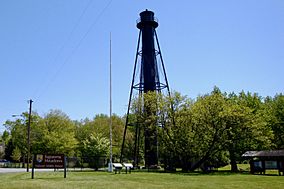Supawna Meadows National Wildlife Refuge facts for kids
Quick facts for kids Supawna Meadows National Wildlife Refuge |
|
|---|---|
|
IUCN Category IV (Habitat/Species Management Area)
|
|

Finn's Point Rear Range Light at the Admin Building and Visitor Contact Station for the refuge
|
|
| Location | Salem County, New Jersey, United States |
| Nearest city | Pennsville, New Jersey |
| Area | 3,230.55 acres (13 km2) |
| Established | 1974 |
| Governing body | U.S. Fish and Wildlife Service |
| Website | Supawna Meadows National Wildlife Refuge |
The Supawna Meadows National Wildlife Refuge is a special place in Salem County, New Jersey. It's a protected area that helps keep nature safe. This refuge is part of the larger Cape May National Wildlife Refuge system.
It sits near the mouth of the Delaware River, which is where the river meets the ocean. This area is just north of the Salem River and south of Pennsville.
Contents
What is Supawna Meadows?
The Supawna Meadows National Wildlife Refuge was created in 1974. Its main job is to protect important wetlands and coastal forests. These areas are super important for many different kinds of animals, especially birds.
Why are Wetlands Important?
The Delaware Bay and its estuary (the part where the river meets the sea) are known around the world as vital wetlands. They are also a special reserve for shorebirds. The refuge itself covers about 3,000 acres (12 km²) of land.
Most of the refuge, about 80 percent, is made up of tidal marshes and coastal forests. Tidal marshes are wetlands that are regularly covered by water from the tides. The water here is brackish, meaning it's a mix of fresh river water and salty ocean water. This mix creates a unique home for many plants and animals.
Animals You Might See
The refuge is a busy place for birds, especially during their long journeys (migrations) in spring and fall. It gives them a safe spot to rest and find food.
Birds of the Refuge
Many types of waterfowl (birds that live on or near water) visit Supawna Meadows. You might see American black ducks, mallards, and northern pintails, especially in winter.
During summer, and also in spring and fall migrations, Sandpipers and other shorebirds use the marsh areas to find food.
Birds from Nearby Islands
A short distance away, Pea Patch Island is home to a huge bird rookery. A rookery is a place where many birds gather to nest and raise their young. Over 6,000 pairs of nine different bird species nest there. It's the biggest rookery for wading birds (birds with long legs that walk in shallow water) on the East Coast, north of Florida. The marshes at Supawna Meadows are very important for these birds. They fly over to the refuge to find food for their chicks during nesting season.
Other Migratory Birds
The higher, drier areas of the refuge are also important. Warblers, sparrows, and other migratory birds use these spots to rest and eat during their travels. Some even stay to nest during the summer.
In late summer, thousands of tree swallows come to the refuge to feed. You might also spot larger birds like Ospreys, bald eagles, northern harriers, short-eared owls, and barn owls. These birds even build their nests right in the refuge.
Plants of the Refuge
The Supawna Meadows area is part of a larger natural region called the Southeastern mixed forests ecoregion. This means it has a mix of different types of trees and plants. One special plant found here is southern wild rice.
Images for kids



